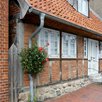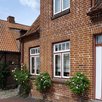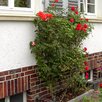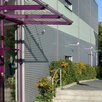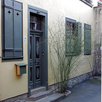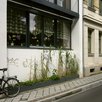Base Greening with Climbing Shrubs, Bushes, etc..
By planting climbers, bushes, or annuals against the base of a building, you can achieve a beautiful effect at a low cost without having to install a wall-bound trellis cable system. These 'low' greenings are also an excellent way to cover or prevent graffiti. You'll simply need to create flower bed borders or single planting pits in front of your facade. Sometimes you can also integrate suspended trellising cables (cables that hang down from the roof creating a curtain-like situation for the plants; rope system 0050 is a good example). Planting bushes in front of the facade is the easiest way to bring greenery onto the building, and often it is the only solution for buildings with special facades that are insulated from the outside and cannot be drilled. Here we'll show you some successful examples, arranged according to plant groups.

Roses
Of the well-known climbing plants, roses (both as shrubs or as high-stem 'standard' roses) are particularly suitable for base planting. Rose shrubs are climbing shrubs that grow tall with their rigid shoots and thorns in the wild. Stem roses are a good flowering solution to be planted in a bed for embellishing the base of a facade, since their stems and flowers develop on an already developed and straight trunk. Stem roses will need a stake or post, while bush roses can benefit from a cable system like our 1010. Refer to the climbing roses profile for more information.
Other Climbing Shrubs
In addition to roses, many from the group of perennial woody climbers ("climbing shrubs") are also suitable: firethorn, cotoneaster, espalier fruits, winter creeper, among others. These plants can eventually become 'wall' plants: you simply lean them against the wall and they will naturally adhere. Other climbers usually need a support (post/pole..) or climbing aid and are therefore seldom suitable for free-standing base plantings (in a flower bed..). The non-woody and less vigorous climbing perennials (hops, for example) and the annual climbing plants can also not be used without a climbing aid; they die when forced to crawl on the ground. From the large group of woody plants, however, many shrubby species are suitable for planting in front of walls, as shown in the photo examples below.
Bamboo and Grasses
In the field of 'modern architecture,' bamboo and grasses are becoming more popular for the base of wall gardens.
Perennials, Biennials, and Annual Plants
With these plants, effects can usually be achieved more quickly than with the ones mentioned above; usually their flowering is more resplendent, and above all, long-lasting. For example, sunflowers are often used in northern Germany, whereas hollyhocks (hollyhock roses / "mallows") have a long tradition in the Baltic area. The choice of plants thus always depends on the location and the regional conditions.

A copse of lilac bushes as climbing shrubs

Annuals (long blooming climbers ), perennials, and climbing shrubs



